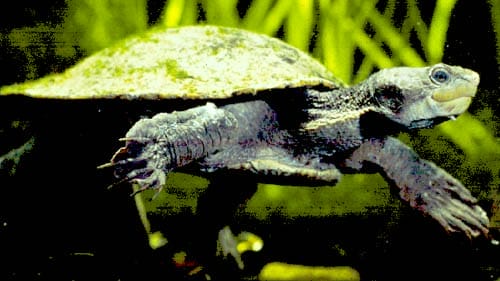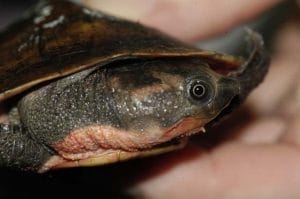Elseya lavarackorum (Gulf Snapping Turtle)
Home > Turtle Database > Elseya lavarackorum (Gulf Snapping Turtle)
Elseya lavarackorum is a large freshwater turtle native to Australia, known for its striking dome-shaped carapace and distinct preference for tropical river systems. First identified in 1997, it is one of the species belonging to the Elseya genus and has been the subject of conservation efforts due to its vulnerability.
Native To These Regions
Queensland (Australia)Native Turtle Species Map – Find Turtles by Region
Scientific Classification
- Kingdom: Animalia
- Phylum: Chordata
- Class: Reptilia
- Order: Testudines
- Family: Chelidae
- Genus: Elseya
- Species: Elseya lavarackorum
Common Names
- Gulf Snapping Turtle
- Lavarack’s Turtle
This Hilarious Turtle Book Might Know Your Pet Better Than You Do
Let’s be real—most turtle care guides feel like reading a textbook written by a sleep-deprived zookeeper.
This one’s not that.
Told from the snarky point of view of a grumpy, judgmental turtle, 21 Turtle Truths You’ll Never Read in a Care Guide is packed with sarcasm, sass, and surprisingly useful insights.
And hey—you don’t have to commit to the whole thing just yet.
Grab 2 free truths from the ebook and get a taste of what your turtle really thinks about your setup, your food choices, and that weird plastic palm tree.
It’s funny, it’s honest, and if you’ve ever owned a turtle who glares at you like you’re the problem—you’ll feel seen.
Identification
Description
Elseya lavarackorum has a dark, dome-shaped carapace that can grow up to 40 cm in length. Its head is broad with a robust, hooked beak used for crushing food, and its limbs are strong and well-suited for swimming.
Sexual Dimorphism
Females tend to be larger than males, especially when it comes to carapace length, though males have longer, thicker tails compared to females.
Check more turtles from the Elseya genus
Native Origin and Distribution
Geographical Range
This species is primarily found in the rivers of Queensland, Australia, specifically in the Gulf of Carpentaria region. Its range has also been noted to extend into parts of the Northern Territory.
Preferred Habitat
Elseya lavarackorum inhabits freshwater rivers and billabongs, preferring slow-moving water with plenty of submerged vegetation and sandy or muddy bottoms.
Behavior
Feeding Habits
It is an omnivorous species, feeding on aquatic plants, small invertebrates, and occasionally carrion. The turtle is primarily a grazer, often seen scavenging along the riverbed.
Predators
Predators of the species include birds of prey, large fish, and occasionally saltwater crocodiles, though human activities pose the greatest threat.
Reproduction
Breeding Season
Breeding typically occurs during the dry season, when water levels are lower, allowing females easier access to sandy riverbanks for nesting.
Reproductive Method
Females lay clutches of up to 20 eggs in nests dug into sandy riverbanks. The incubation period lasts several months, with hatchlings emerging just before the wet season begins.
Conservation
Extinction Status
Elseya lavarackorum is classified as Vulnerable by the IUCN Red List.
Threats
Major threats include habitat destruction from human activities like damming and agriculture, as well as predation by invasive species like feral pigs.
Conservation Measures
Conservation efforts focus on habitat preservation and reducing invasive species’ impacts. Legal protections are also in place, restricting hunting and habitat disruption.
Economic Importance
There is limited economic importance associated with this species, but it contributes to local biodiversity and is a subject of ecotourism in some areas.
Interesting Facts
- The species is named after Australian paleontologist Jim Lavarack, who first identified fossil evidence of the turtle.
- It can remain underwater for extended periods by absorbing oxygen through the lining of its throat, a unique adaptation among turtles.

About Author
Muntaseer Rahman started keeping pet turtles back in 2013. He also owns the largest Turtle & Tortoise Facebook community in Bangladesh. These days he is mostly active on Facebook.















